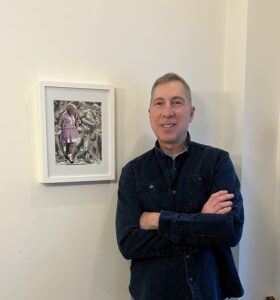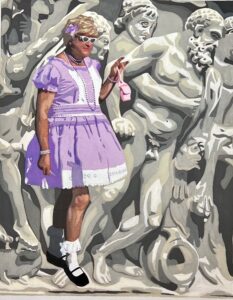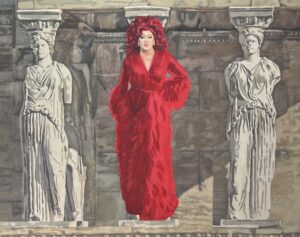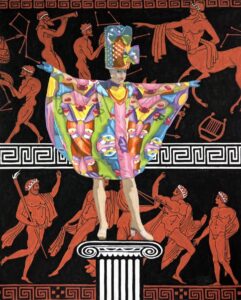As a child, David Pirro dreamed of being an artist. He then spent most of his adult life in a stable career in information technology.

“I’m an ’80s gay,” he says. “The AIDS epidemic was just starting to explode, and a lot of us were looking for health insurance and stability. You had to put some of your dreams away to be practical.”
During the Covid-19 pandemic, Pirro was laid off. He says that, at that moment, two roads opened before him: either searching for a new job in I.T. or turning back toward that childhood dream long ago deemed impractical. Pirro says — a small smile lighting up his face — that, with the love and support of his husband, he decided to forgo the practical route and become a full-time artist.
It turned out to be the right choice. Splitting his time between Provincetown and Boston, he’s shown and sold his work at galleries in Boston and at the Provincetown Art Association and Museum, which he says has been a vital source of community and support. Pirro’s Ptown Flowers #2, which depicts a cartoon dog superimposed over hyper-realistic chrysanthemums, was included in PAAM’s recent Small Works show.

Pirro says that he used to paint now and then before the pandemic but leaving his I.T. job opened him up to an entirely new style. He juxtaposes classical imagery with modern LGBTQ characters. One such painting is Museum Stroll #1, which depicts a drag queen in sunglasses in front of a detail of a Roman relief at the Boston Museum of Fine Art. Pirro says this painting, as well as much of his work, is simultaneously a celebration and a critique of the historical eras he’s culling from.
By juxtaposing these two images, one capturing the rigidity of western antiquity and the other a moment of LGBTQ liberation, the painting questions why certain stories persist — and how narrow definitions of masculinity have come to dominate the cultural conversation.

At first, Pirro says, the relief in the background appears “very masculine, very straight,” but once you view it “through a gay perspective,” this image of supposed masculine strength appears subdued beside the drag queen’s prominant pink purse. The carved figure’s lack of stability as he leans precariously contrasts sharply with the drag queen’s unwavering, upright presence. The images play off each other and make the queen, as Pirro says, “just as important and relevant as this relief they’re showing at the M.F.A.”
Pirro stresses that there is no single message or story to take from any of his paintings and that ambiguity and discovery, both for him and the viewer, is what he loves about being an artist. In his previous life in I.T., he says, “you’re constantly managing or being managed. It’s all very specific.” As an artist, however, you can “do whatever you want to do without having to answer to anybody.”

Pirro says his current style was inspired by children’s encyclopedias that he would pore over when he was a boy. In these books, images from across time and space were placed side by side. “They had images from antiquity next to the Hoover Dam,” he says, “Miró paintings next to Egyptian bracelets.”
To Pirro, these juxtapositions created a sense of joyful expansiveness in the world around him, a joy he tries to recreate in his paintings. “I don’t have a lot of conflict in my life that I need to get out in my art,” he says. “I actually have joy in my life that I want to get out.”
This joy is often expressed through depictions of Provincetown’s drag queens. According to Pirro, as a young gay man living in Boston, it was the drag queens who were his first friends and gave him a sense of community. He says his work is a way of saying “thank you” to them.

Caryatids depicts drag queen and RuPaul’s Drag Race star Tina Burner beside two caryatids, stone carvings of female figures used as pillars in ancient Greek architecture. According to Pirro, the inspiration for this painting came two years ago when, walking down Commercial Street with his husband, Pirro spotted Burner publicizing her forthcoming show. He snapped a photo of her posing, her red hair and feathered dress capturing the summer light just so.
Drawn by the energy she exuded, Pirro used his canvas to place her literally on a pedestal beside these quintessential representations of Western femininity. Pirro believes drag queens have been pushed to the margins, but that their rich history and artistry belongs on the same stage as those classic figures.
“She needs to be on Mount Olympus,” he says. “This is the modern-day caryatid.”



